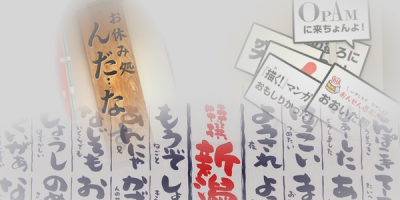
Mrs. Niu, whom she had known for a long time, used to be a gentle soul.
Now, it’s as though she’s a different person. The way she used her eyes, the way her lips curved, even the way she held her cigarette between her index and middle fingers when smoking; Sachiko Makioka, who was with her, felt that Mrs. Niu’s personality suddenly seemed to worsen somehow. These descriptions are from Junichiro Tanizaki’s Sasameyuki (Vol. 1, 1944).
What on earth happened to Mrs. Niu?
In fact, Mrs. Niu began speaking in the Tokyo dialect, possibly due to her friendship with Mrs. Sagara, “a consummate Tokyo lady.”
Among the Hanshin(1) ladies, Sachiko too was able to use the Tokyo dialect fairly fluently. However, Mrs. Niu, while a native of Osaka, spent her school years in Tokyo and through spending a lot of time with her Tokyo friends mastered the art of rapidly speaking in the Tokyo dialect to “such an extent” that Sachiko says “She’s like a different person, and I’m disinclined to relax around her.” She even feels that “the Tokyo dialect is somehow sordid,” and “hearing it spoken irritates me.”
What this example indicates is that words are not simply a media. The argument that only the content of what is being said matters, whether in Tokyo dialect or Osaka, does not work generally.
The question of whether Mrs. Niu speaks in Tokyo dialect or her native Osaka dialect is a matter of her personality. It is a matter of whether or not she becomes “a different person.” In other words, it is a matter of character.
It seems that the “Tokyo native” character that Mrs. Niu deploys was seen as particularly aggressive and unstylish in the Showa-era Hanshin region, and Ashiya, where Sasameyuki is set, specifically. In today’s Hanshin region, one might still find, in certain corners, this sort of reaction to people who speak in the common dialect instead of Osaka dialect, however this is not normally the case any more. The context of this change, which has occurred in the Hanshin region within the last 50-odd years, is the saturation of the region with Tokyo dialect as the major common language, and the accompanying decline in status of the Osaka dialect.
However, I wish to address a different issue here.
Although Mrs. Niu’s standing among others is greatly worsened, why doesn’t she notice, and why does she unconcernedly transform herself from an “Osaka native” to a “Tokyo native” character? (To be continued.)
* * *









(1) Hanshin is another name for the Osaka/Kobe area.